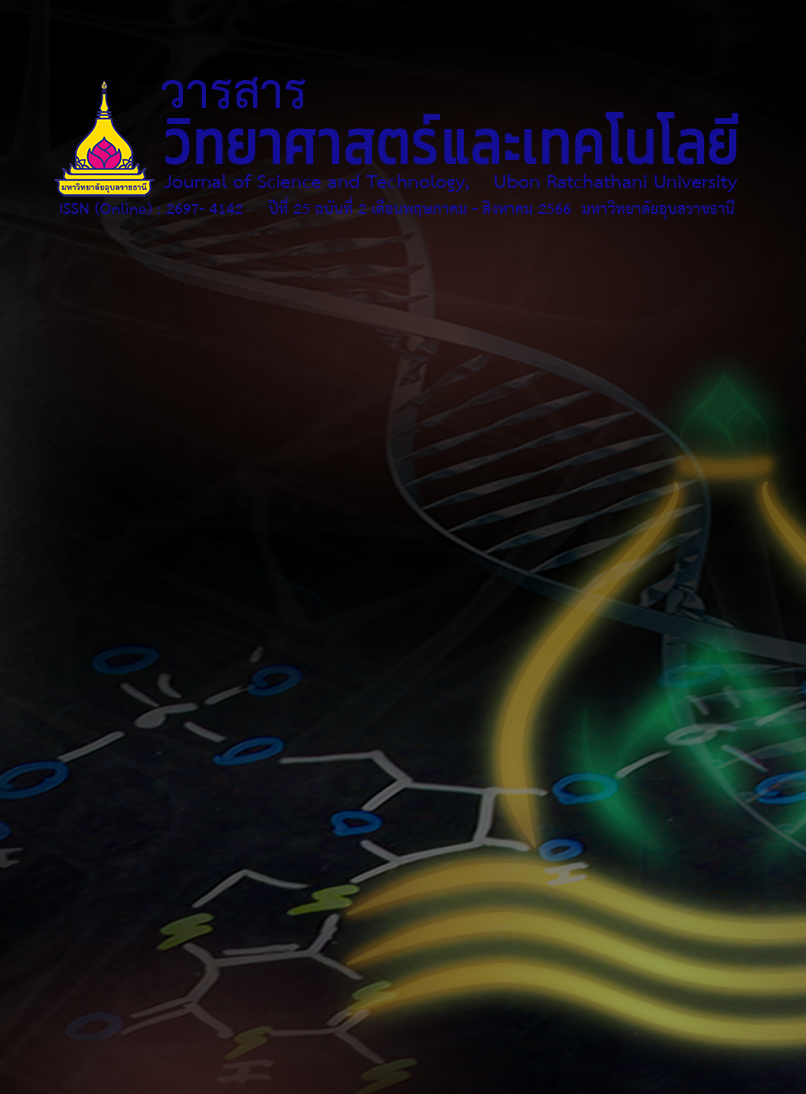ฤทธิ์ต้านอนุมูลอิสระ ปริมาณฟีนอลิกรวม และปริมาณฟลาโวนอยด์รวมของสารสกัดหยาบของไลเคน Parmotrema gardneri (C.W.Dodge) Sérus
Main Article Content
บทคัดย่อ
งานวิจัยนี้มีวัตถุประสงค์เพื่อศึกษาปริมาณฟีนอลิกรวม ปริมาณฟลาโวนอยด์รวม และฤทธิ์ต้านอนุมูลอิสระของสารสกัดหยาบของไลเคน Parmotrema gardneri (C.W.Dodge) Sérus ซึ่งสกัดโดยการแช่ในตัวทำละลาย 3 ชนิด ได้แก่ เอทานอลร้อยละ 95 เอทิลอะซิเตท และอะซิโตน และโดยการต้มในน้ำ การวิเคราะห์ปริมาณฟีนอลิกรวมของสารสกัดใช้วิธี Folin-Ciocalteu colorimetric และการวิเคราะห์ฟลาโวนอยด์ของสารสกัดใช้วิธี aluminium chloride colorimetric ส่วนการวิเคราะห์ฤทธิ์ต้านอนุมูลอิสระของสารสกัดใช้ 3 วิธี คือ Ferric reducing antioxidant power assay (FRAP assay), 2,2′-azinobis (3-ethylbenzothiazoline 6-sulfonate) assay (ABTS assay) และ 2,2-diphenyl-1-picryl-hydrazyl-hydrate assay (DPPH assay) การวิเคราะห์ปริมาณสารออกฤทธิ์ทางชีวภาพพบว่าสารสกัดหยาบของไลเคนที่สกัดด้วยอะซิโตนมีปริมาณฟีนอลิกรวม และปริมาณฟลาโวนอยด์รวมสูงที่สุดเท่ากับ 199.05±0.54 มิลลิกรัมสมมูลของกรดแกลลิกต่อกรัมของสารสกัด และ 170.60±0.88 มิลลิกรัมสมมูลของเควอร์ซิตินต่อกรัมของสารสกัด ตามลำดับ ส่วนการวิเคราะห์ฤทธิ์การต้านอนุมูลอิสระพบว่าสารสกัดหยาบของไลเคนด้วยเอทานอลร้อยละ 95 มีฤทธิ์ต้านอนุมูลอิสระดีที่สุด โดยการทดสอบฤทธิ์ต้านอนุมูลอิสระด้วยวิธี DPPH assay และ ABTS assay ได้ค่า IC50 เท่ากับ 0.85±0.08 มิลลิกรัมต่อมิลลิลิตร และ 0.97±0.00 มิลลิกรัมต่อมิลลิลิตร ตามลำดับ และด้วยวิธี FRAP assay ได้ค่า FRAP value เท่ากับ 4411.49±24.09 มิลลิกรัมของเฟอร์รัสซัลเฟตต่อกรัมของสารสกัด การวิเคราะห์ค่าสหสัมพันธ์ระหว่างปริมาณสารออกฤทธิ์ทางชีวภาพกับฤทธิ์ต้านอนุมูลอิสระของสารสกัดหยาบของไลเคนพบว่าปริมาณฟีนอลิกรวม และปริมาณฟลาโวนอยด์รวมมีความสัมพันธ์แปรผันตรงกับฤทธิ์การต้านอนุมูลอิสระที่วิเคราะห์ด้วยวิธี FRAP assay ในขณะที่ปริมาณฟลาโวนอยด์รวมมีความสัมพันธ์แปรผกผันกับฤทธิ์การต้านอนุมูลอิสระที่วิเคราะห์ด้วยวิธี ABTS assay
Article Details

This work is licensed under a Creative Commons Attribution-NonCommercial-NoDerivatives 4.0 International License.
บทความที่ได้รับการตีพิมพ์เป็นลิขสิทธิ์ของ วารสารวิทยาศาสตร์และเทคโนโลยี มหาวิทยาลัยอุบลราชธานี
ข้อความที่ปรากฏในบทความแต่ละเรื่องในวารสารวิชาการเล่มนี้เป็นความคิดเห็นส่วนตัวของผู้เขียนแต่ละท่านไม่เกี่ยวข้องกับมหาวิทยาลัยอุบลราชธานี และคณาจารย์ท่านอื่นๆในมหาวิทยาลัยฯ แต่อย่างใด ความรับผิดชอบองค์ประกอบทั้งหมดของบทความแต่ละเรื่องเป็นของผู้เขียนแต่ละท่าน หากมีความผิดพลาดใดๆ ผู้เขียนแต่ละท่านจะรับผิดชอบบทความของตนเองแต่ผู้เดียว
References
Zhao, Y., Wang, M. and Xu, B. 2021. A comprehensive review on secondary metabolites and health-promoting effects of edible lichen. Journal of Functional Foods. 80: 104283.
Naksuwankul, K. 2015. Lichen taxonomy. Khon Khaen: Siripun Offset Printing. (in Thai)
Gaikwad, S. and et al. 2014. Growth promoting effects of some lichen metabolites on probiotic bacteria. Journal of Food Science and Technology. 51(10): 2624-2631.
Marcelli, M.P., Benatti, M.N. and Elix, J.A. 2008. New species of Parmotrema containing protocetraric or stictic acid from the coast of Sao Paulo State, southeastern Brazil. Mycotaxon. 105: 235-240.
Kukwa, M. and et al. 2012. Thirty-six species of the lichen genus Parmotrema (Lecanorales, Ascomycota) new to Bolivia. Polish Botanical Journal. 57(1): 243-257.
Mongkolsuk, P. and et al. 2011. Lichen in Mangrove forest at Ban Pak Klong Num Chiew Mueng district, and Black Sand Beach Laem Ngob District, Trat Province. In: Proceedings of the 37th Congress of Science and Technology of Thailand, 10-12 October 2011. Bangkok, Thailand. (in Thai)
Dunkhunthod, B. and Sittisart, P. 2022. Antioxidant activity and cytotoxicity against human cancer cell lines of the aqueous leaf extracts of Smilax luzonensis, Hoya kerrii and Derris elliptica. Journal of Science and Technology, Ubon Ratchathani University. 24(2): 1-11. (in Thai)
Yayinie, M. and et al. 2022. Polyphenols, flavonoids, and antioxidant content of honey coupled with chemometric method: geographical origin classification from Amhara region, Ethiopia. International Journal of Food Properties. 25(1): 76-92.
Youn, J.S. and et al. 2018. Antioxidant activity and contents of leaf extracts obtained from Dendropanax morbifera LEV are dependent on the collecting season and extraction conditions. Food Science and Biotechnology. 28(1): 201-207.
Wannawet, R. and Thiangphet, P. 2017. Determination antioxidant activity and total phenolic compounds of Bean sprouts. In: Proceedings of the 4th National Conference Kamphaengphet Rajabhat University, 22 December 2017. Kamphaengphet, Thailand. (in Thai)
Lertcanawanichakul, M., Chawawisit, K. and Hiransai, P. 2019. Biological activities of extracts from some local plants in Pakpanang, Nakhon Si Thammarat province: Antioxidant and antibacterial activity. Rajamangala University of Technology Srivijaya Research Journal. 11(2): 279-289. (in Thai)
Aoussar, N. and et al. 2017. Chemical composition and antioxidant activity of two lichens species (Pseudevernai furfuracea L and Evernia prunastri L) collected from Morocco. Journal of Materials and Evironmental Science. 8(6): 1968-1976.
Suganya, S. 2015. A study of in-vitro antioxidant activity of Parmotrema grayanum and its bioactive compounds. International Journal of Engineering Sciences and Research Technology. 4(1): 2277-9655.
Sharma, B.C. and Kalikotay, S. 2012. Screening of antioxidant activity of lichens Parmotrema reticulatum and Usnea sp. from Darjeeling hills, India. Journal of Pharmacy. 2(6): 54-60.
Karaahmet, Z., Kinalioglu, K. and Aydin, S. 2019. Antioxidant and antibacterial potencies of Xanthoparmelia conspersa (Ehrh. ex Ach.) Hale and Dermatocarpon miniatum (L.) W. Mann. Lichens from Black Sea Region in Turkey. Gumushane University Journal of Science and Technology. 9(3): 415-424.
Pavan, K.P. and et al. 2020. Isolation, semi-synthesis, free-radicals scavenging, and advanced glycation end products formation inhibitory constituents from Parmotrema tinctorum. Journal of Asian Natural Products Research. 22(10): 976-988.
Wakeel, A. and et al. 2019. Solvent polarity mediates phytochemical yield and antioxidant capacity of Isatis tinctoria. PeerJ. 7: e7857.
Gao, Y. Focsan, A.L. and Kispert, L.D. 2020. The effect of polarity of environment on the antioxidant activity of carotenoids. Chemical Physics Letters. 761: 138098.

